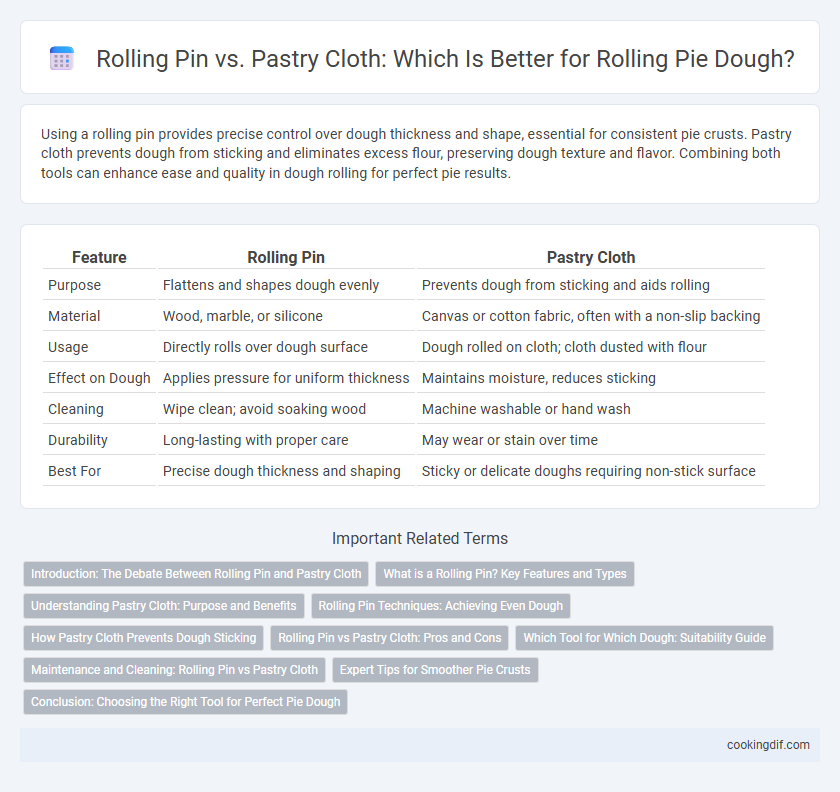Using a rolling pin provides precise control over dough thickness and shape, essential for consistent pie crusts. Pastry cloth prevents dough from sticking and eliminates excess flour, preserving dough texture and flavor. Combining both tools can enhance ease and quality in dough rolling for perfect pie results.
Table of Comparison
| Feature | Rolling Pin | Pastry Cloth |
|---|---|---|
| Purpose | Flattens and shapes dough evenly | Prevents dough from sticking and aids rolling |
| Material | Wood, marble, or silicone | Canvas or cotton fabric, often with a non-slip backing |
| Usage | Directly rolls over dough surface | Dough rolled on cloth; cloth dusted with flour |
| Effect on Dough | Applies pressure for uniform thickness | Maintains moisture, reduces sticking |
| Cleaning | Wipe clean; avoid soaking wood | Machine washable or hand wash |
| Durability | Long-lasting with proper care | May wear or stain over time |
| Best For | Precise dough thickness and shaping | Sticky or delicate doughs requiring non-stick surface |
Introduction: The Debate Between Rolling Pin and Pastry Cloth
Choosing between a rolling pin and a pastry cloth significantly affects dough rolling quality. A rolling pin offers precision and uniform thickness, while a pastry cloth prevents sticking and reduces flour usage. Bakers prioritize either control or convenience based on dough type and desired texture.
What is a Rolling Pin? Key Features and Types
A rolling pin is a cylindrical kitchen tool used to evenly flatten and shape dough, essential for pie making and other baking tasks. Key features include smooth, sturdy surfaces made from wood, marble, or silicone that prevent dough from sticking while providing uniform pressure. Common types include the classic French pin without handles, the American pin with handles, and adjustable rolling pins with thickness rings for precise dough thickness control.
Understanding Pastry Cloth: Purpose and Benefits
A pastry cloth is a durable, tightly woven fabric that prevents dough from sticking while rolling, offering a more controlled and less sticky surface compared to a rolling pin alone. It absorbs excess moisture from the dough, maintaining the right consistency and making the rolling process smoother, especially for delicate pie crusts. Unlike a rolling pin, which shapes the dough, the pastry cloth primarily serves as a non-stick, stabilizing surface that reduces flour usage and helps achieve uniform dough thickness.
Rolling Pin Techniques: Achieving Even Dough
Mastering rolling pin techniques is essential for achieving even dough thickness, crucial for perfect pie crusts. Applying consistent pressure while rolling from the center outward ensures uniform thickness, preventing undercooked or soggy spots. Using a light dusting of flour on both the dough and rolling pin minimizes sticking and tearing, enhancing dough elasticity and final texture.
How Pastry Cloth Prevents Dough Sticking
Pastry cloth creates a non-stick surface by absorbing excess moisture from the dough, which prevents it from sticking during rolling. Its fabric texture offers gentle resistance, ensuring dough maintains its shape without tearing. Unlike rolling pins, which can require additional flour and cause dough dryness, pastry cloth maintains optimal dough hydration and smoothness.
Rolling Pin vs Pastry Cloth: Pros and Cons
A rolling pin offers precise control and even pressure, making it ideal for achieving uniform dough thickness, while a pastry cloth reduces sticking and minimizes flour use, preserving dough texture. However, rolling pins can cause dough to stick without proper flouring, and pastry cloths require regular cleaning and maintenance. Choosing between them depends on the baker's preference for convenience versus dough handling finesse.
Which Tool for Which Dough: Suitability Guide
Rolling pins are ideal for firmer doughs like pie crusts, providing even pressure and smooth surface control for precise thickness. Pastry cloths work best for sticky or delicate doughs, such as sticky sugar cookie dough or soft brioche, preventing sticking without adding extra flour. Choosing between these tools depends on dough consistency and the desired surface texture, ensuring optimal rolling results.
Maintenance and Cleaning: Rolling Pin vs Pastry Cloth
Rolling pins require minimal maintenance, often needing a simple wipe with a damp cloth and occasional oiling if made of wood to prevent cracking. Pastry cloths demand regular washing to remove flour and dough residues, preferably by hand or gentle machine cycles to maintain fabric integrity. While rolling pins dry quickly, pastry cloths must be thoroughly air-dried to prevent mold and odors, making their cleaning routine more involved.
Expert Tips for Smoother Pie Crusts
Using a rolling pin with even pressure ensures a uniformly thin pie crust, while a pastry cloth prevents dough from sticking and tearing without excess flour. Expert bakers recommend chilling dough before rolling to enhance pliability and avoid cracking. Maintaining a cool surface and lightly flouring the cloth helps achieve smoother, flaky crusts ideal for professional-quality pies.
Conclusion: Choosing the Right Tool for Perfect Pie Dough
A rolling pin offers precise control and even pressure, essential for achieving uniform pie dough thickness, while a pastry cloth prevents sticking and reduces flour usage for a cleaner workspace. Selecting the right tool depends on your baking style: use a rolling pin for smooth, consistent rolling and a pastry cloth to streamline the process with less mess. Combining both can enhance dough handling, ensuring a perfectly rolled pie crust every time.
Rolling pin vs pastry cloth for dough rolling Infographic

 cookingdif.com
cookingdif.com